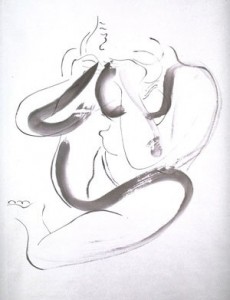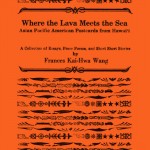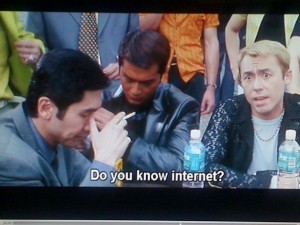Panax Ginseng is a bi-monthly column by Henry W. Leung exploring linguistic and geographic borders in Asian American literature, especially those with hybrid genres, forms, vernaculars, and visions. The column title suggests the English language’s congenital borrowings and derives from the Greek panax, meaning “all-heal,” together with the Cantonese jansam, meaning “man-root.” This perhaps troubling image of one’s roots as panacea informs the column’s readings.
*
 Sharon Lee reading one of her father’s poems,
Sharon Lee reading one of her father’s poems,
from the eulogistic Bruce Lee VLOG Series.
*
Bruce Lee wrote a considerable number of poems, most of which were compiled for the first time in Bruce Lee: Artist of Life (Tuttle, 1999), and I’ve only seen two critical writings on them, both published in The Rumpus a year apart from each other. The first is Dave Landsberger’s “Poetry Kung Fu” from October 2011, and the second is David Biespiel’s “Bruce Lee’s Advice to Poets” from his “Poetry Wire” column in November 2012. Landsberger provides a generous reading of several of Lee’s poems with the intention of expanding the public image of the martial arts superstar, of using Lee as a model of artistic sincerity over artificial self-image, and of expressing his own enthusiasm for his layered portrait of Lee. Landsberger’s readings of the poems’ influences are astute, though his presentation is perhaps overly sentimental, and his exclamatory rhetoric (ironic though it may be) belies the sensationalism he cannot separate from Bruce Lee’s public image even in a treatment of his quieter poetry, as when he concludes an analysis by saying: “Poetry Kung-fu!” Indeed, the essay as a whole—with its demotic reiterations of Bruce Lee not just as a film star, but as a studious “dude who sat on a hood of a car with Steve McQueen eating cylindrical meats,” and sensitive husband to Linda Lee Caldwell—is more of a re-portraiture than a close analysis of poetry, a marveling at more than a study.
What concerns me about Landsberger’s reading, however, is its binary representation of cultural difference. He tells us early on that the above portrait of Lee eating hot dogs with Steve McQueen is “quite possibly the most American image this article will see.” Later, he must preface an explanation of Lee’s themes of longing with, “In Eastern thought . . .” and I’m not entirely sure whether to read this as the same application of aesthetic imperialism common to Lee’s time (merely replacing the word Oriental with Eastern), or as a more modern Orientalism in which the distancing of Lee’s work comes out of praise rather than discredit. In any case, Landsberger feels the need to justify Lee’s longing by noting, inaccurately: “to Western audiences this often reads as insecurity . . .” And he concludes the same section with a line beginning: “Perhaps the only thing Lee traditionally shares with some famous Western poets . . .” The imprecision of his readings aside, these statements are curious to me because even after all this time, even in a modern re-portraiture which addresses the literary sophistication of Bruce Lee’s character, Lee is still a shopworn image representing vast cultural differences and misunderstandings.
Landsberger doesn’t consider the fact that Lee’s poems are written in English, or that born in San Francisco but with a life split between America and Hong Kong, Lee had his choice of languages. That he translated Chinese dynastic poems into English and that his own poems played with Daoist sensibilities doesn’t necessarily place Lee in a position of representing “Eastern thought,” especially in an America which had already seen the popularization of Buddhist Modernism. It may be more apposite to read Lee’s linguistic proclivities as hybrid, not merely on an East/West scale but in the friction of the natural and the urban, a common theme in his early films. Landsberger fixates on the pastoral beauty of Lee’s poems, but neglects to notice the urbanity from which they arise, as in his Seattle poems set on Lake Washington, and especially in “The Surroundings Utter No Sound,” a goodbye poem in which the speaker says, “Anxiously I stopped the car by the roadside,” winding toward a beautiful ending situated somewhere between nature and city:
Like mountain streams, we part and meet again,
Everything is still,
Except the occasional lonely bark of a dog.
Continue reading “Panax Ginseng: Toward a Semiotics of the Body” →








 Sharon Lee reading one of her father’s poems,
Sharon Lee reading one of her father’s poems,



